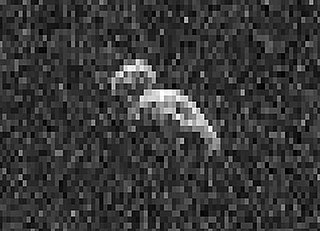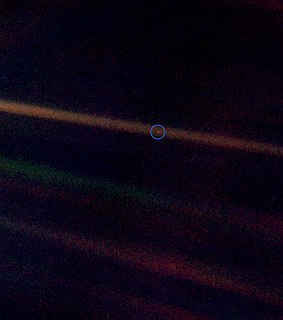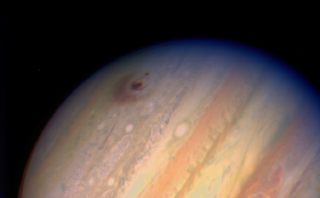
An astronomical body collided with Jupiter , the largest planet in the Solar System, on March 17, 2016. The object in question has not been confirmed by NASA to be an asteroid or comet, but may be so.

An astronomical body collided with Jupiter , the largest planet in the Solar System, on March 17, 2016. The object in question has not been confirmed by NASA to be an asteroid or comet, but may be so.
A video was taken of Jupiter in Mödling on March 17 by an amateur astronomer, Gerrit Kernbauer, with a 20 centimeter telescope. During his filming, a light appeared on the right side of Jupiter as viewed from his lens. [1] Another amateur astronomer, John McKeon, posted a video shot using an 11-inch telescope and an infrared filter of the same event, verifying the clip that Kernbauer had posted. [2]
The manager of the NASA NEO Program Office at NASA's Jet Propulsion Laboratory [3] Paul Chodas said that there was a greater possibility of the object being an asteroid rather than a comet.

An asteroid is a minor planet of the inner Solar System. Sizes and shapes of asteroids vary significantly, ranging from 1-meter rocks to a dwarf planet almost 1000 km in diameter; they are rocky, metallic or icy bodies with no atmosphere.

A comet is an icy, small Solar System body that, when passing close to the Sun, warms and begins to release gases, a process that is called outgassing. This produces a visible atmosphere or coma, and sometimes also a tail. These phenomena are due to the effects of solar radiation and the solar wind acting upon the nucleus of the comet. Comet nuclei range from a few hundred meters to tens of kilometers across and are composed of loose collections of ice, dust, and small rocky particles. The coma may be up to 15 times Earth's diameter, while the tail may stretch beyond one astronomical unit. If sufficiently bright, a comet may be seen from Earth without the aid of a telescope and may subtend an arc of 30° across the sky. Comets have been observed and recorded since ancient times by many cultures and religions.
Comet Shoemaker–Levy 9 broke apart in July 1992 and collided with Jupiter in July 1994, providing the first direct observation of an extraterrestrial collision of Solar System objects. This generated a large amount of coverage in the popular media, and the comet was closely observed by astronomers worldwide. The collision provided new information about Jupiter and highlighted its possible role in reducing space debris in the inner Solar System.

A near-Earth object (NEO) is any small Solar System body whose orbit brings it into proximity with Earth. By convention, a Solar System body is a NEO if its closest approach to the Sun (perihelion) is less than 1.3 astronomical units (AU). If a NEO's orbit crosses the Earth's orbit, and the object is larger than 140 meters (460 ft) across, it is considered a potentially hazardous object (PHO). Most known PHOs and NEOs are asteroids, but a small fraction are comets.

An impact event is a collision between astronomical objects causing measurable effects. Impact events have physical consequences and have been found to regularly occur in planetary systems, though the most frequent involve asteroids, comets or meteoroids and have minimal effect. When large objects impact terrestrial planets such as the Earth, there can be significant physical and biospheric consequences, though atmospheres mitigate many surface impacts through atmospheric entry. Impact craters and structures are dominant landforms on many of the Solar System's solid objects and present the strongest empirical evidence for their frequency and scale.

Asteroid impact avoidance comprises the methods by which near-Earth objects (NEO) on a potential collision course with Earth could be diverted away, preventing destructive impact events. An impact by a sufficiently large asteroid or other NEOs would cause, depending on its impact location, massive tsunamis or multiple firestorms, and an impact winter caused by the sunlight-blocking effect of large quantities of pulverized rock dust and other debris placed into the stratosphere. A collision 66 million years ago between the Earth and an object approximately 10 kilometres wide is thought to have produced the Chicxulub crater and triggered the Cretaceous–Paleogene extinction event that is understood by the scientific community to have caused the extinction of all non-avian dinosaurs.

The Infrared Astronomical Satellite (IRAS) was the first space telescope to perform a survey of the entire night sky at infrared wavelengths. Launched on 25 January 1983, its mission lasted ten months. The telescope was a joint project of the United States (NASA), the Netherlands (NIVR), and the United Kingdom (SERC). Over 250,000 infrared sources were observed at 12, 25, 60, and 100 micrometer wavelengths.

Catalina Sky Survey is an astronomical survey to discover comets and asteroids. It is conducted at the Steward Observatory's Catalina Station, located near Tucson, Arizona, in the United States.

The Panoramic Survey Telescope and Rapid Response System located at Haleakala Observatory, Hawaii, US, consists of astronomical cameras, telescopes and a computing facility that is surveying the sky for moving or variable objects on a continual basis, and also producing accurate astrometry and photometry of already-detected objects. In January 2019 the second Pan-STARRS data release was announced. At 1.6 petabytes, it is the largest volume of astronomical data ever released.
Hubble search for transition comets was a study involving amateur astronomers and the use of the Hubble Space Telescope, one of only six studies involving amateur astronomers approved by NASA.
2007 WD5 is an Apollo asteroid some 50 m (160 ft) in diameter and a Mars-crosser asteroid first observed on 20 November 2007, by Andrea Boattini of the Catalina Sky Survey. Early observations of 2007 WD5 caused excitement amongst the scientific community when it was estimated as having as high as a 1 in 25 chance of colliding with Mars on 30 January 2008. However, by 9 January 2008, additional observations allowed NASA's Near Earth Object Program (NEOP) to reduce the uncertainty region resulting in only a 1-in-10,000 chance of impact. 2007 WD5 most likely passed Mars at a distance of 6.5 Mars radii. Due to this relatively small distance and the uncertainty level of the prior observations, the gravitational effects of Mars on its trajectory are unknown and, according to Steven Chesley of NASA's Jet Propulsion Laboratory Near-Earth Object program, 2007 WD5 is currently considered 'lost' (see lost asteroids).

Discovery and exploration of the Solar System is observation, visitation, and increase in knowledge and understanding of Earth's "cosmic neighborhood". This includes the Sun, Earth and the Moon, the major planets Mercury, Venus, Mars, Jupiter, Saturn, Uranus, and Neptune, their satellites, as well as smaller bodies including comets, asteroids, and dust.

A potentially hazardous object (PHO) is a near-Earth object – either an asteroid or a comet – with an orbit that can make close approaches to the Earth and is large enough to cause significant regional damage in the event of impact. They are defined as having a minimum orbit intersection distance with Earth of less than 0.05 astronomical units and an absolute magnitude of 22 or brighter. More than 99% of the known potentially hazardous objects are not an impact threat over the next 100 years. As of September 2022, only 17 potentially hazardous objects are listed on the Sentry Risk Table as objects that are known not to be a threat over the next hundred years are excluded. Over hundreds if not thousands of years, "potentially hazardous" asteroids have the potential for their orbits to evolve to live up to their namesake.
Richard A. Kowalski is an American astronomer who has discovered numerous asteroids and comets, among them, many near-Earth objects.

The 2009 Jupiter impact event, occasionally referred to as the Wesley impact, was a July 2009 impact event on Jupiter that caused a black spot in the planet's atmosphere. The impact area covered 190 million square kilometers, similar in area to the planet's Little Red Spot and approximately the size of the Pacific Ocean. The impactor is estimated to have been about 200 to 500 meters in diameter.

2010 KQ is a small asteroid-like object that has been discovered in an orbit about the Sun that is so similar to the Earth's orbit that scientists strongly suspect it to be a rocket stage that escaped years ago from the Earth–Moon system. The object was discovered on May 16, 2010 by Richard Kowalski at the Catalina Sky Survey, and has subsequently been observed by many observers, including Bill Ryan and Peter Birtwhistle (England). It was given the asteroid designation 2010 KQ by the Minor Planet Center in Cambridge, Massachusetts, who identified its orbit as being very similar to that of the Earth.
Anthony Wesley is an Australian computer programmer and amateur astronomer, known for his discoveries of the 2009 and 2010 Jupiter impact events.

Gennadiy Vladimirovich Borisov is a Russian telescope maker and amateur astronomer who discovered the first-known interstellar comet, 2I/Borisov, in 2019.

In modern times, numerous impact events on Jupiter have been observed, the most significant of which was the collision of Comet Shoemaker–Levy 9 in 1994. Jupiter is the most massive planet in the Solar System and thus has a vast sphere of gravitational influence, the region of space where an asteroid capture can take place under favorable conditions.